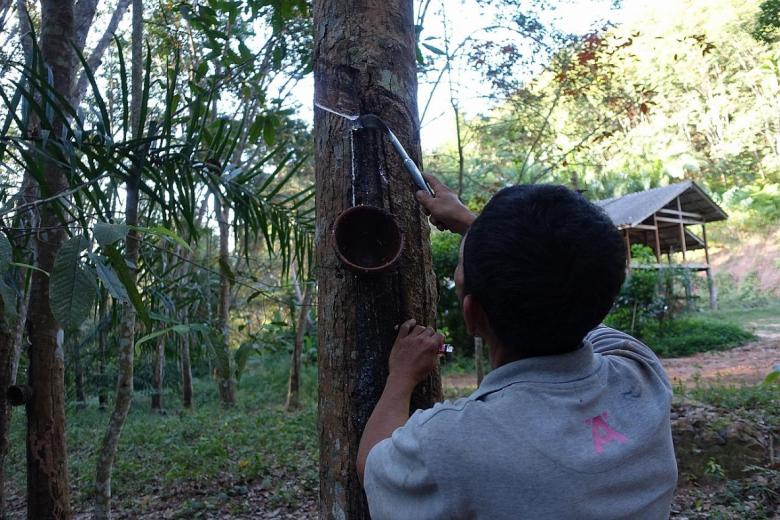Prices for commodity once known as ‘white gold’ set to continue growing this year
The torrential rains since the start of the year have brought misery to Thailand’s rubber producers.
But the restricted supply could be good news for rubber prices as demand for the commodity is now set to exceed supply.
Thailand, the world’s largest rubber producer, will lose around 10 per cent of its output in the 2016-2017 crop year due to flooding, said the Association of Natural Rubber Producing Countries last Friday.
But even before the floods in Thailand, rubber prices were already on a path of recovery.

A rubber tapper working on the tree in Thailand. THE STRAITS TIMES FILE PHOTO
Supply was restricted in recent years as major rubber producing countries, including Indonesia and Malaysia, slashed their annual productions substantially to raise prices.
A recent report on commodities by the Singapore Exchange (SGX) noted that the rubber market had entered the year on a bearish note as concerns of oversupply and poor macroeconomic conditions loomed.
The report said: “However, fundamentals of the market quickly tightened during the course of the year as supply was consistently disrupted by poor weather conditions, and global demand surprised to the upside.”
Although the rubber market has taken a beating due to the poor economy and oversupply in recent years, it has an illustrious history. Once touted as white gold, rubber originates from the Hevea Brasiliensis tree, a species native to Brazil but also found thriving in many parts of South-east Asia.
The outlook for rubber is expected to improve this year amid the gradual global recovery, driven by emerging markets and developing economies.
President Of The Thai Rubber Association, Mr Chaiyos Sincharoenkul
In fact, rubber plantations were a major part of Singapore’s economy from 1903 until World War II, covering 40 per cent of Singapore’s land area in the 1930s.
Although rubber’s glory days may be far behind, industry players are still hopeful about its future.
A report by the Thailand Board of Investment last August noted that global rubber consumption was expected to grow at a rate of 1.8 per cent last year, and forecasts put this year and next year’s growth rates at 2.9 per cent and 3.3 per cent respectively.
“The outlook for rubber is expected to improve this year amid the gradual global recovery, driven by emerging markets and developing economies,” Mr Chaiyos Sincharoenkul, president of the Thai Rubber Association told the Bangkok Post last week.
An SGX survey of more than 250 industry participants on the outlook of the commodities market agreed with his sentiment – majority of respondents expect rubber prices to finish this year higher.
‘CAUTIOUSLY OPTIMISTIC’
But the market seems “cautiously optimistic” on the commodity’s fundamental outlook, with 85 per cent of the respondents expecting Chinese demand to increase at least moderately this year compared to last year, noted the same SGX survey.
While rubber trees here now have ornamental rather than economic purpose, there are still options available for keen investors.
SGX offers two SICOM Rubber Futures – RSS 3 and TSR 20 – to provide market participants with a reliable pricing basis as a point of reference for their physical cargo and to manage price risks.
Futures are standardised contracts listed on an exchange. Buyers and sellers agree to buy or sell a quantity of a commodity at a pre-determined price for delivery and payment at a later date.
In this case, there are two different rubber products – Technically Specified Rubber (TSR), which can be reformed into blocks to be used in tyre manufacturing, and Ribbed Smoked Sheet (RSS), which can be rolled into sheets.
According to SGX’s report, SICOM TSR 20 and RSS 3 futures saw strong growth momentum last year with volumes more than doubling to over 7 million tonnes.
Local investors can also consider an unexpected latex product – rubber gloves.
A recent report by DBS Vickers Securities pointed out that the Malaysian Rubber Gloves Manufacturers Association expects the demand for healthcare gloves to grow by 8 per cent to 10 per cent this year.
DBS analysts Siti Ruzanna Mohd Faruk and Paul Yong highlighted companies Top Glove and Riverstone, which are listed on the Malaysian stock exchange and SGX.
They noted that the share prices of glove makers have rallied on the back of a stronger US dollar since early November.
But they also cautioned that their price-earning valuation – a barometer of whether a stock is too expensive – is slightly above its five-year mean.
This suggests that the positives have already largely been priced in.
“We have ‘hold’ calls for all glove companies under our coverage but prefer Top Glove and Riverstone from a valuation perspective,” said the analysts.




























